Bunt H., Beun R.-J., Borghuis T. (eds.) Multimodal Human-Computer Communication. Systems, Techniques, and Experiments
Подождите немного. Документ загружается.

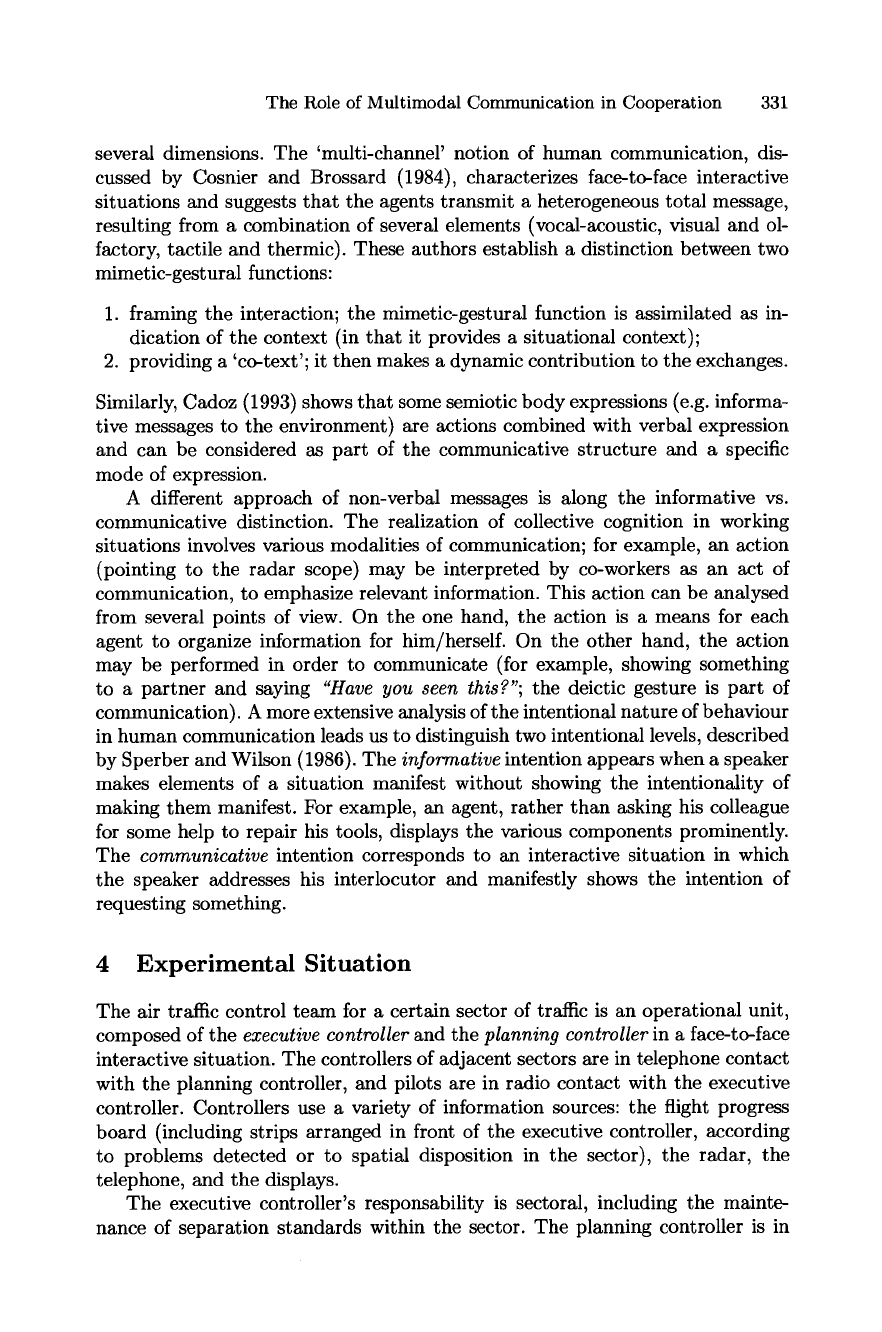
The Role of Multimodal Communication in Cooperation 331
several dimensions. The 'multi-channer notion of human communication, dis-
cussed by Cosnier and Brossard (1984), characterizes face-to-face interactive
situations and suggests that the agents transmit a heterogeneous total message,
resulting from a combination of several elements (vocal-acoustic, visual and ol-
factory, tactile and thermic). These authors establish a distinction between two
mimetic-gestural functions:
1. framing the interaction; the mimetic-gestural function is assimilated as in-
dication of the context (in that it provides a situational context);
2. providing a 'co-text'; it then makes a dynamic contribution to the exchanges.
Similarly, Cadoz (1993) shows that some semiotic body expressions (e.g. informa-
tive messages to the environment) are actions combined with verbal expression
and can be considered as part of the communicative structure and a specific
mode of expression.
A different approach of non-verbal messages is along the informative vs.
communicative distinction. The realization of collective cognition in working
situations involves various modalities of communication; for example, an action
(pointing to the radar scope) may be interpreted by co-workers as an act of
communication, to emphasize relevant information. This action can be analysed
from several points of view. On the one hand, the action is a means for each
agent to organize information for him/herself. On the other hand, the action
may be performed in order to communicate (for example, showing something
to a partner and saying
"Have you seen this?";
the deictic gesture is part of
communication). A more extensive analysis of the intentional nature of behaviour
in human communication leads us to distinguish two intentional levels, described
by Sperber and Wilson (1986). The
informative
intention appears when a speaker
makes elements of a situation manifest without showing the intentionality of
making them manifest. For example, an agent, rather than asking his colleague
for some help to repair his tools, displays the various components prominently.
The
communicative
intention corresponds to an interactive situation in which
the speaker addresses his interlocutor and manifestly shows the intention of
requesting something.
4 Experimental Situation
The air traffic control team for a certain sector of traffic is an operational unit,
composed of the
executive controller
and the
planning controller
in a face-to-face
interactive situation. The controllers of adjacent sectors are in telephone contact
with the planning controller, and pilots are in radio contact with the executive
controller. Controllers use a variety of information sources: the flight progress
board (including strips arranged in front of the executive controller, according
to problems detected or to spatial disposition in the sector), the radar, the
telephone, and the displays.
The executive controller's responsability is sectoral, including the mainte-
nance of separation standards within the sector. The planning controller is in
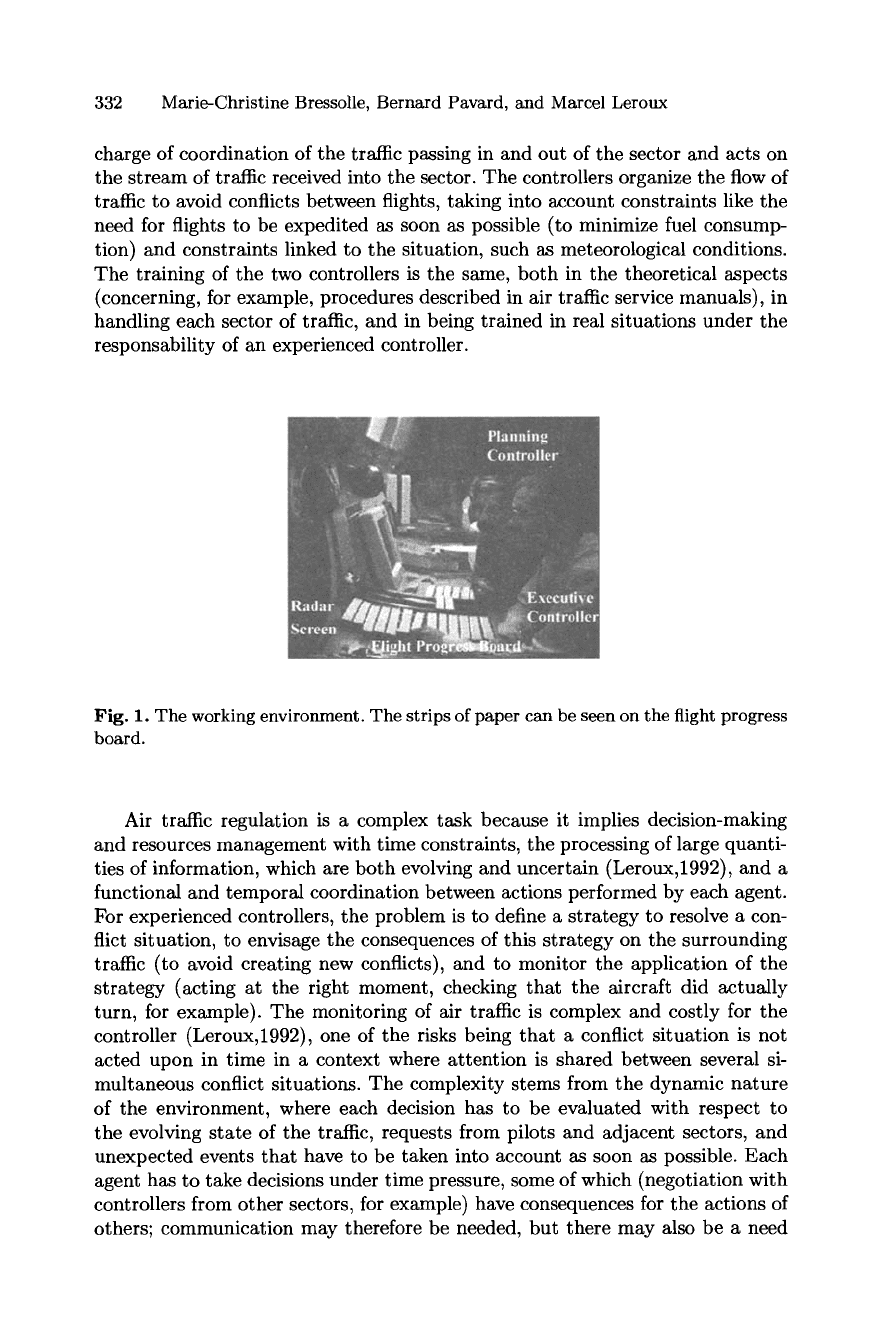
332 Marie-Christine Bressolle, Bernard Pavard, and Marcel Leroux
charge of coordination of the traffic passing in and out of the sector and acts on
the stream of traffic received into the sector. The controllers organize the flow of
traffic to avoid conflicts between flights, taking into account constraints like the
need for flights to be expedited as soon as possible (to minimize fuel consump-
tion) and constraints linked to the situation, such as meteorological conditions.
The training of the two controllers is the same, both in the theoretical aspects
(concerning, for example, procedures described in air traffic service manuals), in
handling each sector of traffic, and in being trained in real situations under the
responsability of an experienced controller.
Fig. 1. The working environment. The strips of paper can be seen on the flight progress
board.
Air traffic regulation is a complex task because it implies decision-making
and resources management with time constraints, the processing of large quanti-
ties of information, which are both evolving and uncertain (Leroux,1992), and a
functional and temporal coordination between actions performed by each agent.
For experienced controllers, the problem is to define a strategy to resolve a con-
flict situation, to envisage the consequences of this strategy on the surrounding
traffic (to avoid creating new conflicts), and to monitor the application of the
strategy (acting at the right moment, checking that the aircraft did actually
turn, for example). The monitoring of air traffic is complex and costly for the
controller (Leroux,1992), one of the risks being that a conflict situation is not
acted upon in time in a context where attention is shared between several si-
multaneous conflict situations. The complexity stems from the dynamic nature
of the environment, where each decision has to be evaluated with respect to
the evolving state of the traffic, requests from pilots and adjacent sectors, and
unexpected events that have to be taken into account as soon as possible. Each
agent has to take decisions under time pressure, some of which (negotiation with
controllers from other sectors, for example) have consequences for the actions of
others; communication may therefore be needed, but there may also be a need
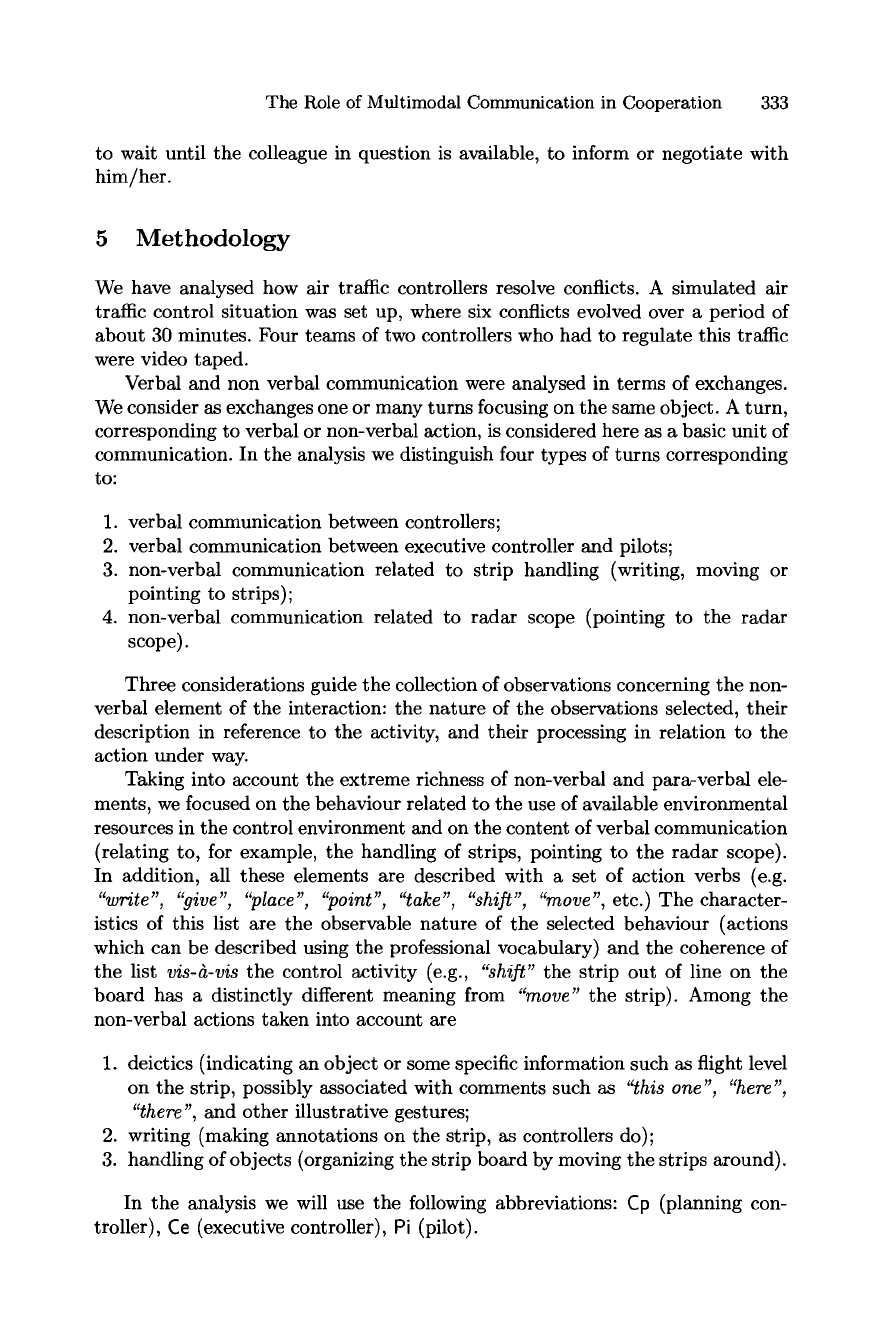
The Role of Multimodal Communication in Cooperation 333
to wait until the colleague in question is available, to inform or negotiate with
him/her.
5 Methodology
We have analysed how air traffic controllers resolve conflicts. A simulated air
traffic control situation was set up, where six conflicts evolved over a period of
about 30 minutes. Four teams of two controllers who had to regulate this traffic
were video taped.
Verbal and non verbal communication were analysed in terms of exchanges.
We consider as exchanges one or many turns focusing on the same object. A turn,
corresponding to verbal or non-verbal action, is considered here as a basic unit of
communication. In the analysis we distinguish four types of turns corresponding
to:
1. verbal communication between controllers;
2. verbal communication between executive controller and pilots;
3. non-verbal communication related to strip handling (writing, moving or
pointing to strips);
4. non-verbal communication related to radar scope (pointing to the radar
scope).
Three considerations guide the collection of observations concerning the non-
verbal element of the interaction: the nature of the observations selected, their
description in reference to the activity, and their processing in relation to the
action under way.
Taking into account the extreme richness of non-verbal and para-verbal ele-
ments, we focused on the behaviour related to the use of available environmental
resources in the control environment and on the content of verbal communication
(relating to, for example, the handling of strips, pointing to the radar scope).
In addition, all these elements are described with a set of action verbs (e.g.
"write", "give", "place", "point", "take", "shift", "move",
etc.)The character-
istics of this list are the observable nature of the selected behaviour (actions
which can be described using the professional vocabulary) and the coherence of
the list
vis-a-vis
the control activity (e.g.,
"shift"
the strip out of line on the
board has a distinctly different meaning from
"move"
the strip). Among the
non-verbal actions taken into account are
1. deictics (indicating an object or some specific information such as flight level
on the strip, possibly associated with comments such as
'~this one", "here",
"there",
and other illustrative gestures;
2. writing (making annotations on the strip, as controllers do);
3. handling of objects (organizing the strip board by moving the strips around).
In the analysis we will use the following abbreviations: Cp (planning con-
troller), Ce (executive controller), Pi (pilot).
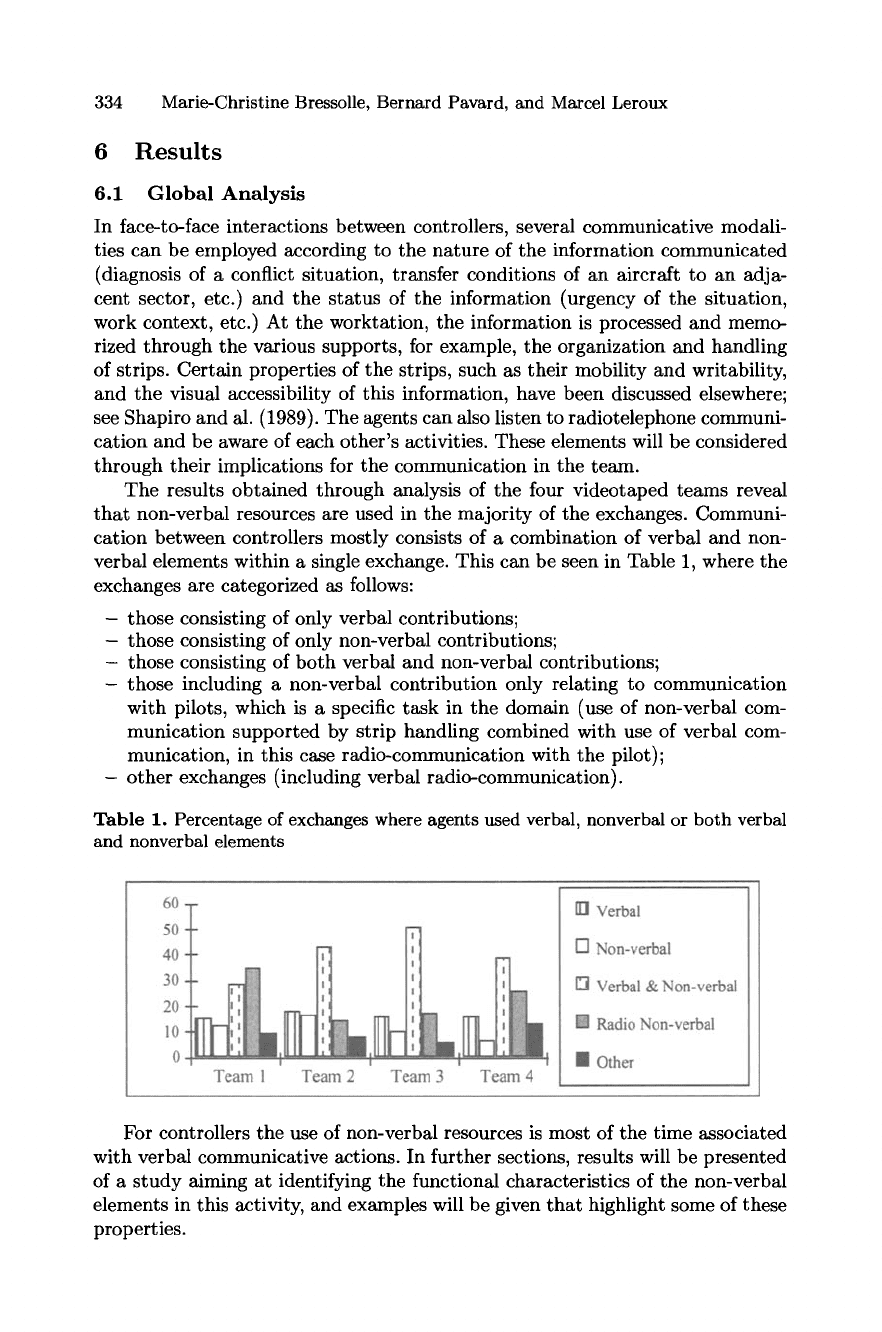
334 Marie-Christine Bressolle, Bernard Pavard, and Marcel Leroux
6 Results
6.1 Global Analysis
In face-to-face interactions between controllers, several communicative modali-
ties can be employed according to the nature of the information communicated
(diagnosis of a conflict situation, transfer conditions of an aircraft to an adja-
cent sector, etc.) and the status of the information (urgency of the situation,
work context, etc.) At the worktation, the information is processed and memo-
rized through the various supports, for example, the organization and handling
of strips. Certain properties of the strips, such as their mobility and writability,
and the visual accessibility of this information, have been discussed elsewhere;
see Shapiro and al. (1989). The agents can also listen to radiotelephone communi-
cation and be aware of each other's activities. These elements will be considered
through their implications for the communication in the team.
The results obtained through analysis of the four videotaped teams reveal
that non-verbal resources are used in the majority of the exchanges. Communi-
cation between controllers mostly consists of a combination of verbal and non-
verbal elements within a single exchange. This can be seen in Table 1, where the
exchanges are categorized as follows:
- those consisting of only verbal contributions;
- those consisting of only non-verbal contributions;
- those consisting of both verbal and non-verbal contributions;
- those including a non-verbal contribution only relating to communication
with pilots, which is a specific task in the domain (use of non-verbal com-
munication supported by strip handling combined with use of verbal com-
munication, in this case radio-communication with the pilot);
-
other exchanges (including verbal radio-communication).
Table 1. Percentage of exchanges where agents used verbal, nonverbal or both verbal
and nonverbal elements
For controllers the use of non-verbal resources is most of the time associated
with verbal communicative actions. In further sections, results will be presented
of a study aiming at identifying the functional characteristics of the non-verbal
elements in this activity, and examples will be given that highlight some of these
properties.
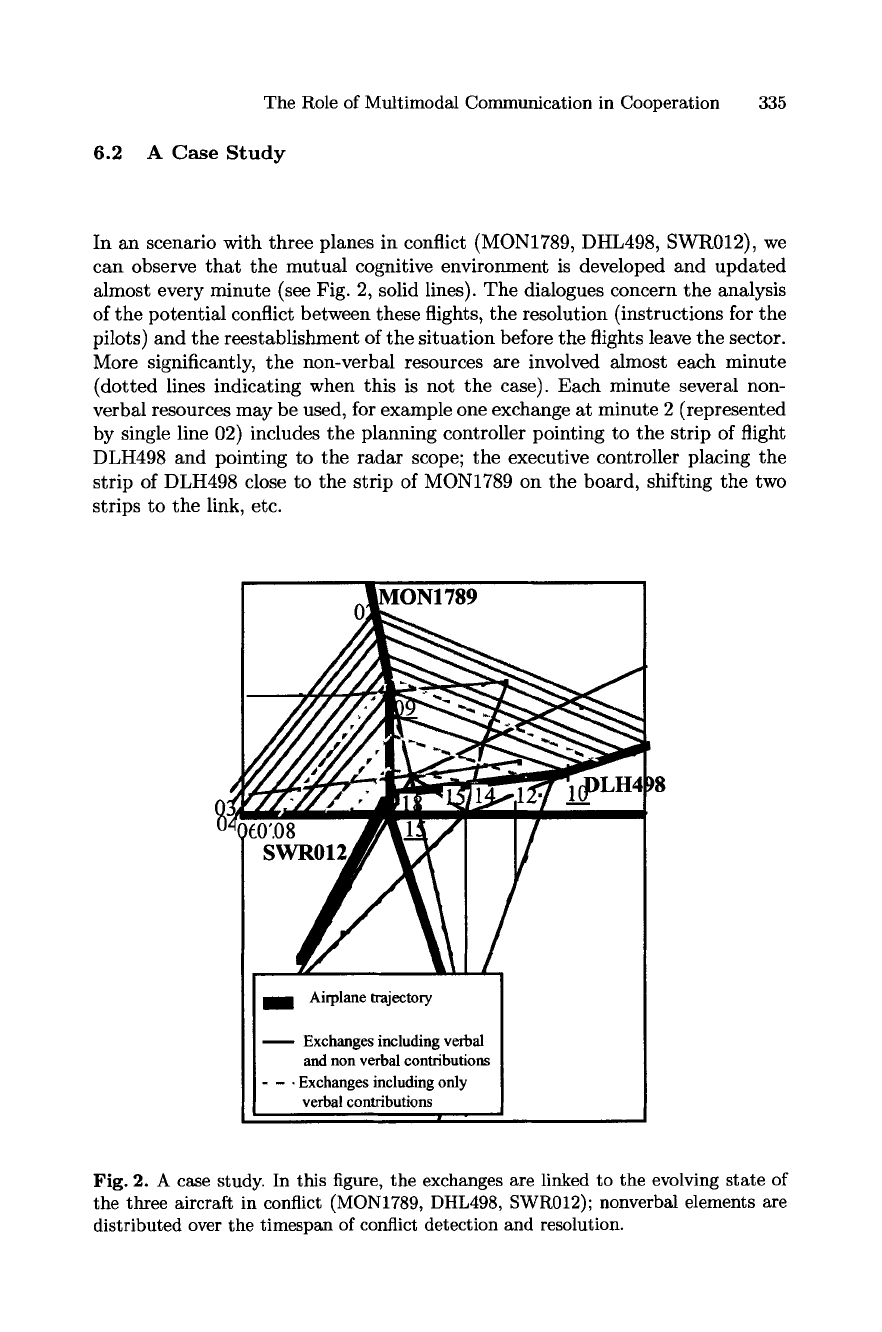
The Role of Multimodal Communication in Cooperation
6.2 A Case Study
335
In an scenario with three planes in conflict (MON1789, DHL498, SWR012), we
can observe that the mutual cognitive environment is developed and updated
almost every minute (see Fig. 2, solid lines). The dialogues concern the analysis
of the potential conflict between these flights, the resolution (instructions for the
pilots) and the reestablishment of the situation before the flights leave the sector.
More significantly, the non-verbal resources are involved almost each minute
(dotted lines indicating when this is not the case). Each minute several non-
verbal resources may be used, for example one exchange at minute 2 (represented
by single line 02) includes the planning controller pointing to the strip of flight
DLH498 and pointing to the radar scope; the executive controller placing the
strip of DLH498 close to the strip of MON1789 on the board, shifting the two
strips to the link, etc.
8
Airplane trajectory
Exchanges including verbal
and non verbal contributions
- - 9 Exchanges including only
verbal contributions
|
Fig. 2. A case study. In this figure, the exchanges are linked to the evolving state of
the three aircraft in conflict (MON1789, DHL498, SWR012); nonverbal elements are
distributed over the timespan of conflict detection and resolution.
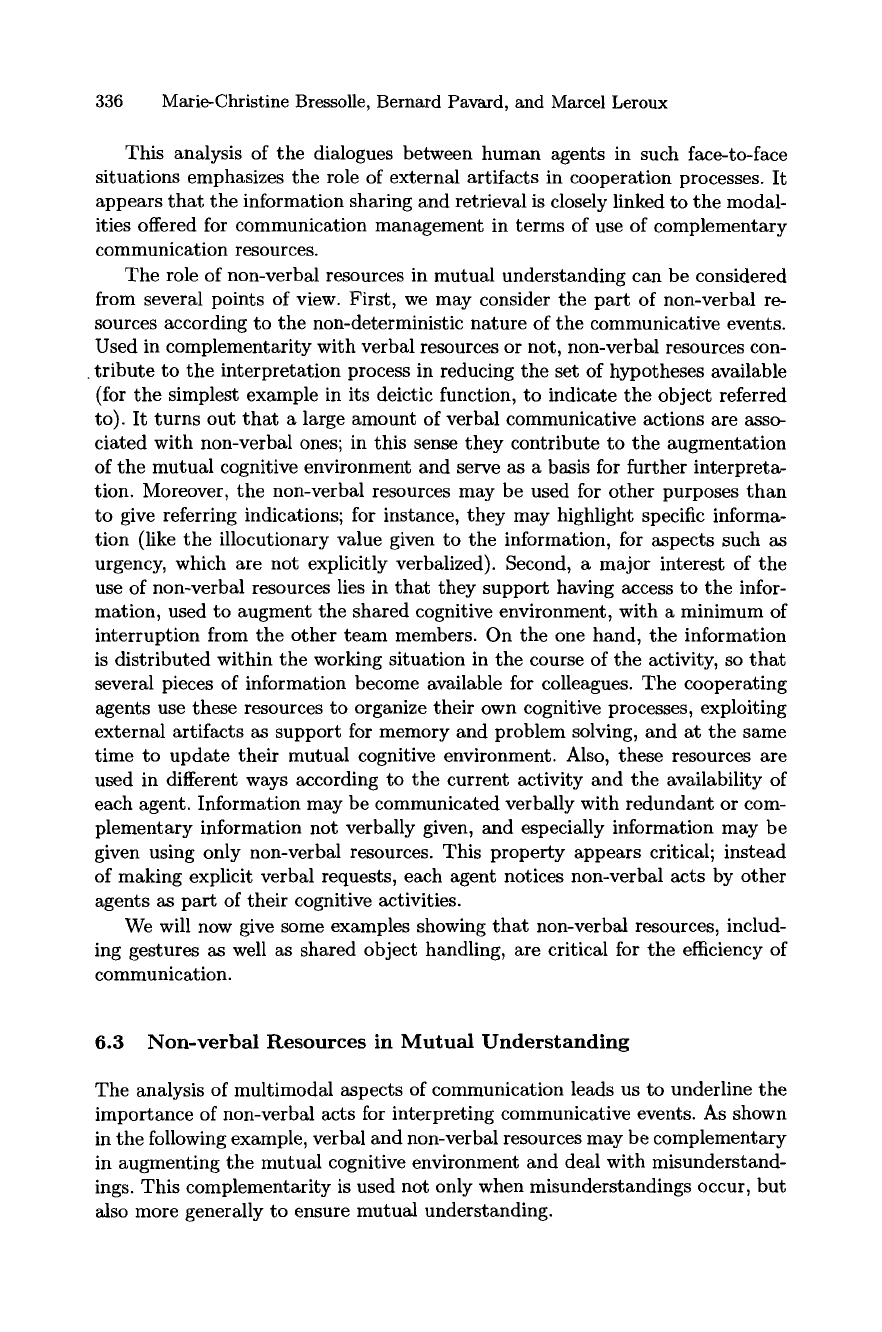
336 Marie-Christine Bressolle, Bernard Pavard, and Marcel Leroux
This analysis of the dialogues between human agents in such face-to-face
situations emphasizes the role of external artifacts in cooperation processes. It
appears that the information sharing and retrieval is closely linked to the modal-
ities offered for communication management in terms of use of complementary
communication resources.
The role of non-verbal resources in mutual understanding can be considered
from several points of view. First, we may consider the part of non-verbal re-
sources according to the non-deterministic nature of the communicative events.
Used in complementarity with verbal resources or not, non-verbal resources con-
. tribute to the interpretation process in reducing the set of hypotheses available
(for the simplest example in its deictic function, to indicate the object referred
to). It turns out that a large amount of verbal communicative actions are asso-
ciated with non-verbal ones; in this sense they contribute to the augmentation
of the mutual cognitive environment and serve as a basis for further interpreta-
tion. Moreover, the non-verbal resources may be used for other purposes than
to give referring indications; for instance, they may highlight specific informa-
tion (like the illocutionary value given to the information, for aspects such as
urgency, which are not explicitly verbalized). Second, a major interest of the
use of non-verbal resources lies in that they support having access to the infor-
mation, used to augment the shared cognitive environment, with a minimum of
interruption from the other team members. On the one hand, the information
is distributed within the working situation in the course of the activity, so that
several pieces of information become available for colleagues. The cooperating
agents use these resources to organize their own cognitive processes, exploiting
external artifacts as support for memory and problem solving, and at the same
time to update their mutual cognitive environment. Also, these resources are
used in different ways according to the current activity and the availability of
each agent. Information may be communicated verbally with redundant or com-
plementary information not verbally given, and especially information may be
given using only non-verbal resources. This property appears critical; instead
of making explicit verbal requests, each agent notices non-verbal acts by other
agents as part of their cognitive activities.
We will now give some examples showing that non-verbal resources, includ-
ing gestures as well as shared object handling, are critical for the efficiency of
communication.
6.3 Non-verbal Resources in Mutual Understanding
The analysis of multimodal aspects of communication leads us to underline the
importance of non-verbal acts for interpreting communicative events. As shown
in the following example, verbal and non-verbal resources may be complementary
in augmenting the mutual cognitive environment and deal with misunderstand-
ings. This complementarity is used not only when misunderstandings occur, but
also more generally to ensure mutual understanding.

The Role of Multimodal Communication in Cooperation 337
Example 1: Strip pointing in communication regulation
In the following example, the exchange is based on the establishment of a refer-
ence flight, while two aircraft are present in the sector, SWR011 and SWR012.
The executive controller's hypothesis is that the SWR concerned is SWR012,
and the planning controller's contributions, both pointing at the strip and com-
menting verbally, allow him to make the flight explicit. This example underlines
the richness of multimodal interaction, which helps to ensure successful commu-
nication.
Fig. 3. Strip pointing in mutual understanding. In the first picture, the executive
controller wants to take the strip of flight SWR012; in the second picture the planning
controller points to the strip of flight SWR011.
Team 3 -III
Cp-Ce:
(...)
Cp-Ce:
Ce-Cp:
Cp-Ce:
Ce-Cp:
Cp-Ce:
"watch out for the SWR eh?"
"We can transfer
the SWR on frequency already"
(Ce
wants to take SWR012 strip)
"the SWR012"
(Cp
points to SWR012 strip)
"no, not that one"
"all
right,the SWR011 you mean at 280"
"no, no ...
01i"
(Cp points to SWR011 strip)
Interaction associated with situation depicted in Fig. 3
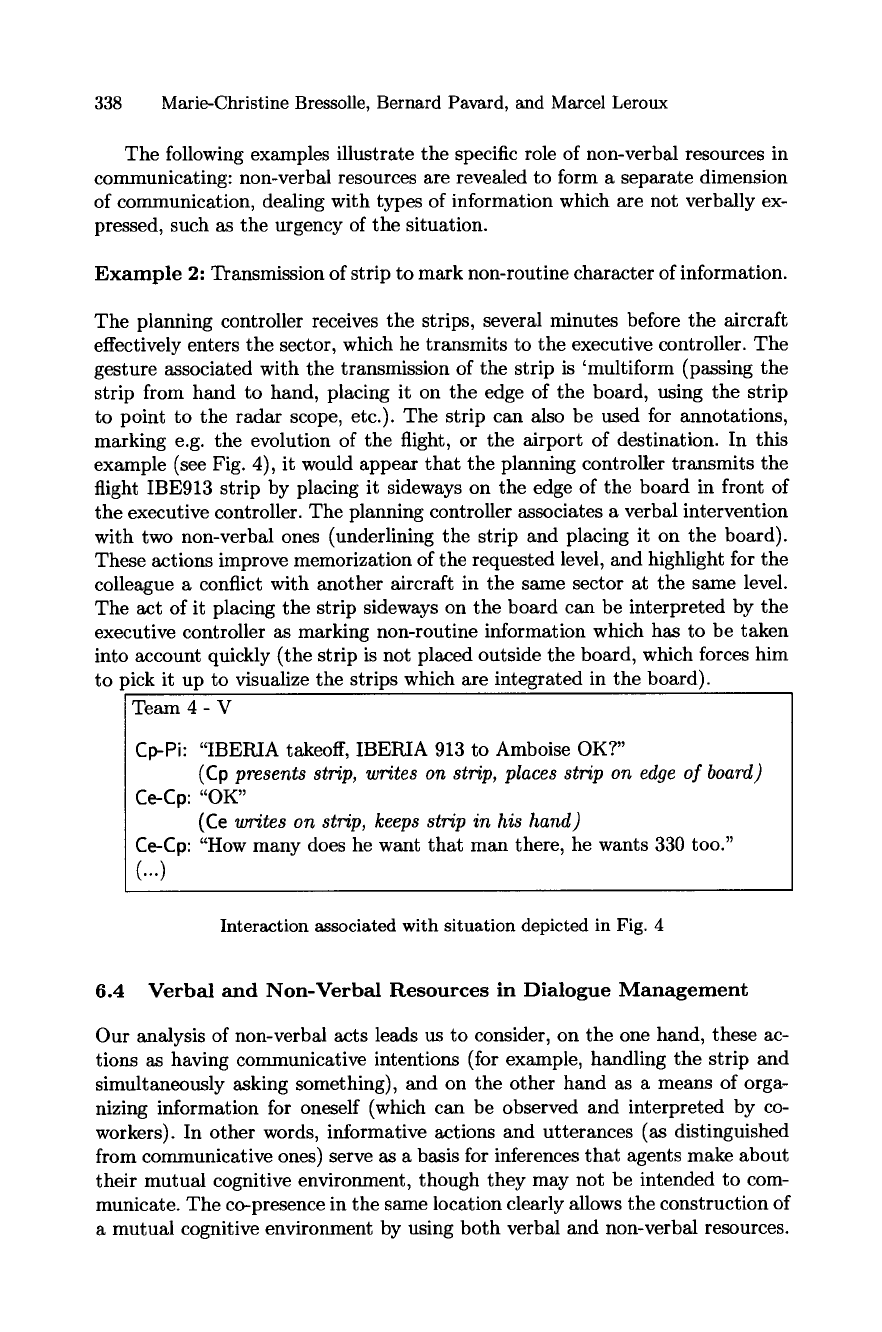
338 Marie-Christine Bressolle, Bernard Pavard, and Marcel Leroux
The following examples illustrate the specific role of non-verbal resources in
communicating: non-verbal resources are revealed to form a separate dimension
of communication, dealing with types of information which are not verbally ex-
pressed, such as the urgency of the situation.
Example 2: Transmission of strip to mark non-routine character of information.
The planning controller receives the strips, several minutes before the aircraft
effectively enters the sector, which he transmits to the executive controller. The
gesture associated with the transmission of the strip is 'multiform (passing the
strip from hand to hand, placing it on the edge of the board, using the strip
to point to the radar scope, etc.). The strip can also be used for annotations,
marking e.g. the evolution of the flight, or the airport of destination. In this
example (see Fig. 4), it would appear that the planning controller transmits the
flight IBE913 strip by placing it sideways on the edge of the board in front of
the executive controller. The planning controller associates a verbal intervention
with two non-verbal ones (underlining the strip and placing it on the board).
These actions improve memorization of the requested level, and highlight for the
colleague a conflict with another aircraft in the same sector at the same level.
The act of it placing the strip sideways on the board can be interpreted by the
executive controller as marking non-routine information which has to be taken
into account quickly (the strip is not placed outside the board, which forces him
to pick it up to visualize the strips which are integrated in the board).
Team 4- V
Cp-Pi:
"IBERIA takeoff, IBERIA 913 to Amboise OK?"
(Cp presents strip, writes on strip, places strip on edge of board)
Ce-Cp:
"OK"
(Ce writes on strip, keeps strip in his hand)
Ce-Cp: "How many does he want that man there, he wants 330 too."
(...)
Interaction associated with situation depicted in Fig. 4
6.4 Verbal and Non-Verbal
Resources in Dialogue Management
Our analysis of non-verbal acts leads us to consider, on the one hand, these ac-
tions as having communicative intentions (for example, handling the strip and
simultaneously asking something), and on the other hand as a means of orga-
nizing information for oneself (which can be observed and interpreted by co-
workers). In other words, informative actions and utterances (as distinguished
from communicative ones) serve as a basis for inferences that agents make about
their mutual cognitive environment, though they may not be intended to com-
municate. The co-presence in the same location clearly allows the construction of
a mutual cognitive environment by using both verbal and non-verbal resources.
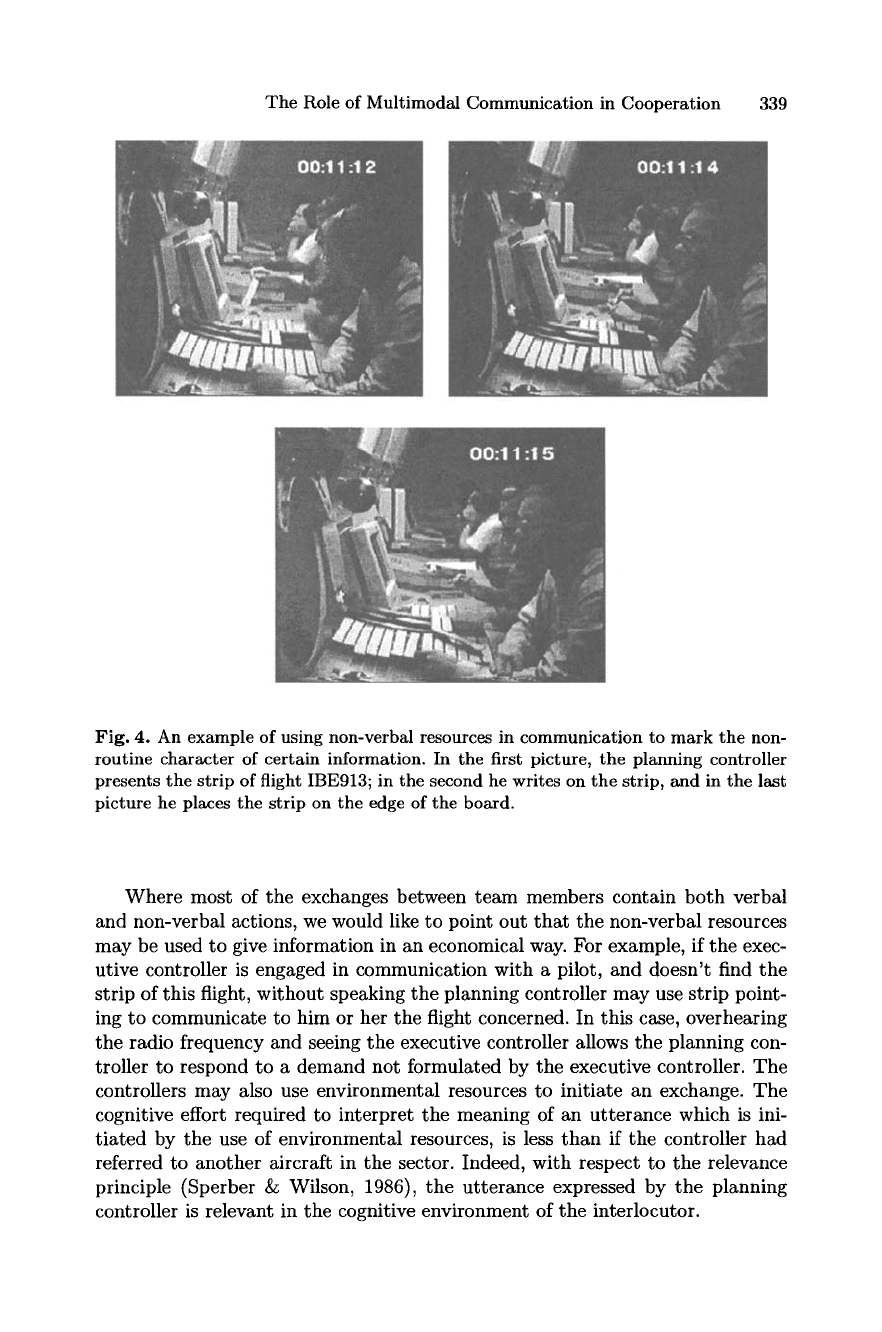
The Role of Multimodal Communication in Cooperation 339
Fig. 4. An example of using non-verbal resources in communication to mark the non-
routine character of certain information. In the first picture, the planning controller
presents the strip of flight IBE913; in the second he writes on the strip, and in the last
picture he places the strip on the edge of the board.
Where most of the exchanges between team members contain both verbal
and non-verbal actions, we would like to point out that the non-verbal resources
may be used to give information in an economical way. For example, if the exec-
utive controller is engaged in communication with a pilot, and doesn't find the
strip of this flight, without speaking the planning controller may use strip point-
ing to communicate to him or her the flight concerned. In this case, overhearing
the radio frequency and seeing the executive controller allows the planning con-
troller to respond to a demand not formulated by the executive controller. The
controllers may also use environmental resources to initiate an exchange. The
cognitive effort required to interpret the meaning of an utterance which is ini-
tiated by the use of environmental resources, is less than if the controller had
referred to another aircraft in the sector. Indeed, with respect to the relevance
principle (Sperber & Wilson, 1986), the utterance expressed by the planning
controller is relevant in the cognitive environment of the interlocutor.
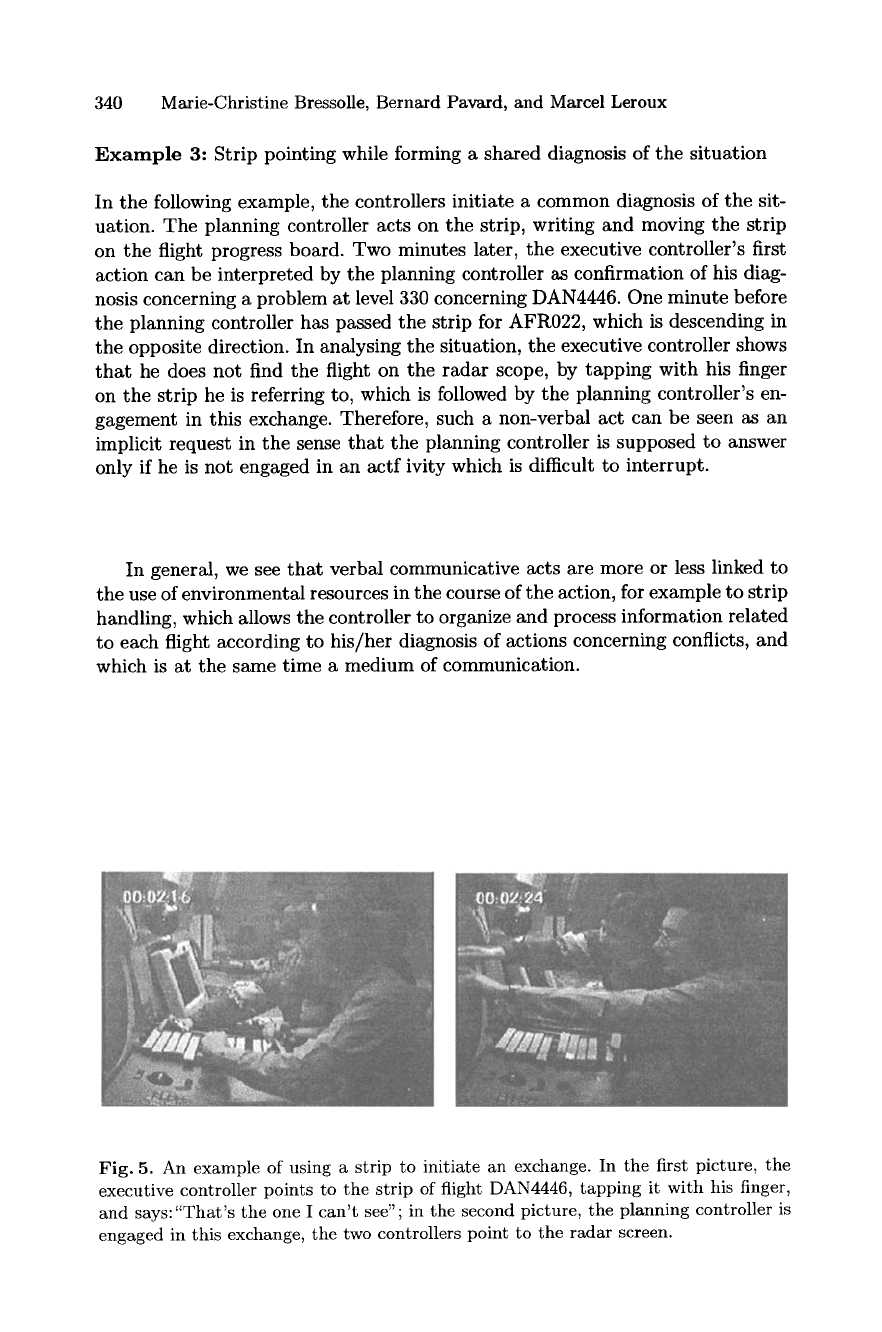
340 Marie-Christine Bressolle, Bernard Pavard, and Marcel Leroux
Example 3: Strip pointing while forming a shared diagnosis of the situation
In the following example, the controllers initiate a common diagnosis of the sit-
uation. The planning controller acts on the strip, writing and moving the strip
on the flight progress board. Two minutes later, the executive controller's first
action can be interpreted by the planning controller as confirmation of his diag-
nosis concerning a problem at level 330 concerning DAN4446. One minute before
the planning controller has passed the strip for AFR022, which is descending in
the opposite direction. In analysing the situation, the executive controller shows
that he does not find the flight on the radar scope, by tapping with his finger
on the strip he is referring to, which is followed by the planning controller's en-
gagement in this exchange. Therefore, such a non-verbal act can be seen as an
implicit request in the sense that the planning controller is supposed to answer
only if he is not engaged in an actf ivity which is difficult to interrupt.
In general, we see that verbal communicative acts are more or less linked to
the use of environmental resources in the course of the action, for example to strip
handling, which allows the controller to organize and process information related
to each flight according to his/her diagnosis of actions concerning conflicts, and
which is at the same time a medium of communication.
Fig. 5. An example of using a strip to initiate an exchange. In the first picture, the
executive controller points to the strip of flight DAN4446, tapping it with his finger,
and says:"That's the one I can't see"; in the second picture, the planning controller is
engaged in this exchange, the two controllers point to the radar screen.
